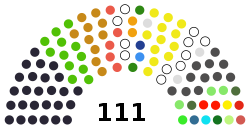Member of the National Parliament of Papua New Guinea
| National Parliament of Papua New Guinea | |
|---|---|
| 10th Parliament | |
 |
|
| Type | |
| Type | |
|
Term limits
|
5 years |
| Structure | |
| Seats | 111 (89 open electorates and 22 provincial electorates) |
 |
|
|
Political groups
|
Government
Opposition
Others
|
| Elections | |
| Instant-runoff voting | |
|
Last election
|
24 June 2017 - 8 July 2017 |
| Meeting place | |
 |
|
| National Parliament House, Port Moresby | |
| Website | |
| www |
|
Government
Opposition
Others
The National Parliament of Papua New Guinea is the unicameral national legislature in Papua New Guinea. It was created in 1964 as the House of Assembly of Papua and New Guinea but gained its current name after the nation was granted independence in 1975.
The 111 members of parliament serve five-year terms, 89 of whom are chosen from single-member "open" electorates, which are sometimes referred to as "seats" but are officially known as constituencies. The remaining 22 are chosen from single-member provincial electorates: the 20 provinces, the autonomous province of Bougainville (North Solomons), and the National Capital District. Each provincial member becomes governor of their province unless they take a ministerial position, in which case the governorship passes to an open member of the province.
From 1964 until 1977 an Optional Preferential Voting System was used. The first past the post system was used from 1977 until 2002. Electoral reforms introduced by former Prime Minister Mekere Morauta introduced Limited Preferential Voting, in which voters numbered three preferred candidates. LPV was first used nationally in the 2007 election.
As in other Commonwealth realms, the party or coalition with the most seats in the parliament is invited by the Governor-General to form a government, and its leader subsequently becomes Prime Minister of Papua New Guinea. The Prime Minister then appoints his cabinet from fellow parliament members. (Members of parliament are seated in a similar manner to other Westminster system parliaments, but use chairs instead of benches.)
...
Wikipedia
